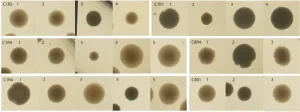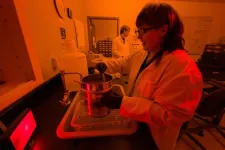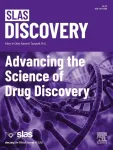(Press-News.org) Sediments recovered from the base of the Camp Century ice core show that northwestern Greenland was ice-free during a period of history known to have exhibited some of the lowest global ice volumes -- the Marine Isotope Stage (MIS) 11 interglacial period. The absence of ice at that location means that the Greenland Ice Sheet must have contributed more 1.4 meters of sea-level equivalent to global sea level during the interglacial – a period in which average global air temperature was similar to what we’ll soon experience, given human-caused climate warming. The climate conditions of past interglacials – periods during Earth’s climatic history characterized by warmer global temperatures and reduced global ice coverage – provide opportunities to better understand how Earth’s cryosphere will respond to our warming climate and contribute to sea level rise. However, well-dated sedimentary records from areas formally ice-free during interglacial periods are rare or difficult to obtain due to present-day ice cover. One notable exception is the Camp Century ice core from northwestern Greenland, which contained rare frozen subglacial sediments suggesting that the region was ice-free at some point during the Pleistocene. Using luminescence dating and cosmogenic nuclide data, Andrew Christ and colleagues analyzed the sediments and found they were deposited by flowing water in an ice-free tundra environment during the MIS 11 interglacial (~416 thousand years ago) after first being exposed at the surface and to sunlight less than 16,000 years earlier. Then, to better understand the deglaciation of Greenland during MIS 11, Christ et al. used an ensemble of ice sheet models and found that for the Camp Century location to be ice-free, melting of the ice sheet would have contributed to at least 1.4 meters of sea-level equivalent to the global mean sea level of the interglacial, which was between 6 and 13 meters higher than present. “If moderate warmth for 29 [thousand years] during MIS 11 resulted in significant ice loss from Greenland, then rapid, prolonged, and considerable anthropogenic Arctic warming will likely cause melting of the [Greenland Ice Sheet], raise sea level, and trigger additional climate feedbacks in the coming centuries,” write Christ et al.
END
Northwestern Greenland was ice-free 400,000 years ago, according to Camp Century sediments
Summary author: Walter Beckwith
2023-07-20
ELSE PRESS RELEASES FROM THIS DATE:
Global GPS measurements indicate observable phase of fault slip two hours before large earthquakes
2023-07-20
Analysis of Global Positioning System (GPS) time-series data from nearly 100 large earthquakes worldwide has provided evidence for the existence of a precursory phase of fault slip occurring two hours before seismic rupture. “If it can be confirmed that earthquake nucleation often involves an hours-long precursory phase, and the means can be developed to reliably measure it, a precursor warning could be issued,” writes Roland Bürgmann in a related Perspective. The ability to predict large earthquakes has been a longstanding yet elusive goal. Short-term ...
Biobank-scale imaging data unveils the genetic architecture of the human skeletal form
2023-07-20
Combining data from full-body x-ray images and associated genomic data from more than 30,000 UK Biobank participants, researchers have helped illuminate the genetic basis of human skeletal proportions. The findings not only provide new insights into the evolution of the human skeletal form and its role in musculoskeletal disease, but they also demonstrate the utility of using population-scale imaging data from biobanks to understand both disease-related and normal physical variation among humans. Of all primates, humans are the only ones to have evolved to be normally bipedal, an adaptation that may have facilitated the use of tools and accelerated cognitive development. ...
Genes that shape bones identified, offering clues about our past and future
2023-07-20
Using artificial intelligence to analyze tens of thousands of X-ray images and genetic sequences, researchers from The University of Texas at Austin and New York Genome Center have been able to pinpoint the genes that shape our skeletons, from the width of our shoulders to the length of our legs.
The research, published as the cover article in Science, pulls back a curtain on our evolutionary past and opens a window into a future where doctors can better predict patients’ risks of developing conditions such as back pain or arthritis in later life.
“Our research is a powerful demonstration of the impact of AI in medicine, particularly when it comes to analyzing ...
Immune systems develop ‘silver bullet’ defences against common bacteria
2023-07-20
Immune systems develop specific genes to combat common bacteria such as those found in food, new research shows.
Previous theories have suggested that antimicrobial peptides – a kind of natural antibiotics – have a general role in killing a range of bacteria.
However, the new study, published in Science, examined how the immune systems of fruit flies are shaped by the bacteria in their food and environment.
The researchers, from the Swiss Federal Institute of Technology and the University of Exeter, found two peptides that each control a single bacterial species commonly encountered by the flies.
“We know that an animal’s food and environment ...
These bones were made for walking
2023-07-20
NEW YORK, NY--Perhaps the most profound advance in primate evolution occurred about 6 million years ago when our ancestors started walking on two legs. The gradual shift to bipedal locomotion is thought to have made primates more adaptable to diverse environments and freed their hands to make use of tools, which in turn accelerated cognitive development. With those changes, the stage was set for modern humans.
The genetic changes that made possible the transition from knuckle-based scampering in great apes to upright walking in humans have now been uncovered in a new study by researchers ...
Observing the long-postulated intermediate of catalytic amination reactions
2023-07-20
Led by Director CHANG Sukbok, scientists from the Center for Catalytic Hydrocarbon Functionalizations within the Institute for Basic Science (IBS) have made a breakthrough in understanding the structure and reactivity of a key intermediate in catalytic reactions. This intermediate, known as a transition metal-nitrenoid, plays a crucial role in converting hydrocarbons into amides, which are important in pharmaceuticals and materials science.
In chemical reactions, intermediates are substances that are formed and consumed during the transformation of reactants into products. Hence, understanding these intermediates ...
Living together: Microbial communities are more than the sum of their parts
2023-07-20
Microbial communities are widely used biotechnology suppliers for processes like manufacturing biofuels and new foods, or helping crops grow better. To engineer successful communities, scientists need to predict whether microorganisms can live and work together. One popular predictive rule states that if a pair of microbes will coexist, they will also coexist in a bigger community of microbes. A study published in Science now found that this simple rule will not always work.
Just like plants and animals, microorganisms live in complex ecological communities consisting of multiple species that ...
Greenland has greener history than previously thought, says USU Geoscientist
2023-07-20
LOGAN, UTAH, USA -- New analysis of samples collected from underneath Greenland’s ice sheet reveal the Arctic island was much greener as recently as 416,000 years ago. The findings overturn previous views that Greenland’s continental glacier, which covers about 80 percent of the 836,3000-square-mile land mass, has persisted for the last two and a half million years.
“We’re discovering the ice sheet is much more sensitive to climate change than we previously thought,” says Utah State University geoscientist ...
New advancements in assay development research
2023-07-20
Oak Brook, IL – The July 2023 issue of SLAS Discovery, the open access journal focused on research progressing drug discovery, is now available. Volume 28, Issue 5, contains one short communication and four full-length articles covering assay quality metrics, fluorescence resonance energy transfer (FRET) and small molecule glycomimetics and other high-throughput screening-related research.
Full-length articles
Mathematical relationships between control group variability and assay quality metrics
Authored by early ...
The present and future of computing get a boost from new research
2023-07-20
The world's computing needs have grown exponentially in recent years due to an explosion of technology. To meet the needs for the next technological leap, the scientific community is working to improve current processing capabilities and simultaneously develop entirely new computing methods.
Two new papers from the research group of Jean Anne Incorvia, a professor in the Cockrell School of Engineering’s Chandra Family of Electrical and Computer Engineering, aim to contribute to both of these scientific needs. Together, they offer improvements ...
LAST 30 PRESS RELEASES:
Manganese gets its moment as a potential fuel cell catalyst
“Gifted word learner” dogs can pick up new words by overhearing their owners’ talk
More data, more sharing can help avoid misinterpreting “smoking gun” signals in topological physics
An illegal fentanyl supply shock may have contributed to a dramatic decline in deaths
Some dogs can learn new words by eavesdropping on their owners
Scientists trace facial gestures back to their source. before a smile appears, the brain has already decided
Is “Smoking Gun” evidence enough to prove scientific discovery?
Scientists find microbes enhance the benefits of trees by removing greenhouse gases
KAIST-Yonsei team identifies origin cells for malignant brain tumor common in young adults
Team discovers unexpected oscillation states in magnetic vortices
How the brain creates facial expressions
Researchers observe gas outflow driven by a jet from an active galactic nucleus
Pitt student finds familiar structure just 2 billion years after the Big Bang
Evidence of cross-regional marine plastic pollution in green sea turtles
Patients with clonal hematopoiesis have increased heart disease risk following cancer treatment
Stem cell therapy for stroke shows how cells find their way in the brain
Environment: Up to 4,700 tonnes of litter flows down the Rhine each year
Maternal vaccine receipt and infant hospital and emergency visits for influenza and pertussis
Interim safety of RSVpreF vaccination during pregnancy
Stem cell engineering breakthrough paves way for next-generation living drugs
California grants $7.4 million to advance gene-edited stem cell therapy for Friedreich’s ataxia
Victoria’s Secret grant backs cutting-edge ovarian cancer research
Research paves the way for safer colonoscopy bowel prep for people with compromised gut health
JMIR Publications and Sweden's National Library announce renewal and expansion of flat-fee unlimited open access partnership for 2026
A new 3D-printed solar cell that’s transparent and color-tunable
IV iron is the cost-effective treatment for women with iron deficiency anemia and heavy menstrual bleeding
Doing good pays off: Environmentally and socially responsible companies drive value and market efficiency
City of Hope and Cellares to automate manufacturing of solid tumor CAR T cell therapy
Short-circuiting pancreatic cancer
Groundbreaking mapping: how many ghost particles all the Milky Way’s stars send towards Earth
[Press-News.org] Northwestern Greenland was ice-free 400,000 years ago, according to Camp Century sedimentsSummary author: Walter Beckwith





